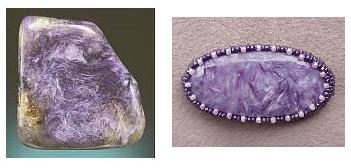( Fr- charoite; Ger- Charoit;
Nor- karoitt; Rus-![]() )
)
CHAROITE, (K,Na)5(Ca,Ba,Sr)8(Si6O15)2(Si6O16)(OH,F)·nH2O

A. Charoite (height - 4 cm) from type locality, south of Olekminsk, Republic of Sakha (Yakutia), Siberia, Russia. Waterworks. (© photo by Jeffrey A. Scovil)
B, Charoite pin (greater axis, including beadwork - 4.2 cm). Debra Pyeatt Designs. (© photo by Debra Pyeatt, webmaster@debrapyeatt.com)
DESCRIPTION: In the language of
petrography, most marketplace charoite would be called charoitite (in
the same sense that most material marketed as serpentine is
serpentinite). This is so because virtually all gemrock
"charoite" consists only predominantly -- not
wholly(!) -- of the mineral charoite.
Colors - violet (frequently described as
lilac or periwinkle ...), commonly with a pattern variously described
by such terms as streaked, swirls, feathers and mottled. In
addition, colors such as orange, dark green and nearly
black are commonly present; these additional colors manifest
other mineral constituents -- e.g.,
the orange may be tinaksite, the dark green, aegirine, etc. --
the names and possible colors of of which are given under the REMARKS
subheading.
H. (effective hardness) 5 - 6
S.G. 2.54-2.79
Light transmission - translucent
to opaque
Luster - pearly to subvitreous
Breakage - irregular to subconchoidal
Miscellany -
some "fibers" exhibit chatoyancy.
OTHER NAMES:
NOTEWORTHY LOCALITY: In the interfluve area between the Chara and Olekma rivers, south of Olekminsk in the Republic of Sakha (Yakutia), which is in east central Siberia, northeast of Lake Baikal. The locality is about 520 km (325 miles) northeast of the northern tip of Lake Baikal. According to some reports, the deposit is now "exhausted." (e.g., fairystones.walst.ru)
REMARKS: This name of this gemrock is
recorded variously as
based on its
occurrence near the the Chara River OR on
the basis of the
impression it leads to -- i.e.,
it is noted that "chary" in Russian means "charms"
or "magic"
(see www.skylineminerals.com/charoite -- However, to date, I have
found no such Russian word meaning either charms or magic; the
nearest possibility would transliterate to a ocharov...). In any case,
according to the CNMMN of the IMA, the type
locality is the "Charo River, Marun
alkaline complex, Yakutia (SW), Siberia, Russia." By the
way, some maps show Yakutia as Jakutsk, Yakutsk or Jakutiya as
well as calling it the Republic of Sakha.
Lapidaries
indicate that charoite is rather difficult to work because
it tends to break while cutting and polishing it.
Some have impregnated it with plastics to reduce this problem but the
end products (which I have not seen or at least not recognized) are
considered to be less appealing to potential purchasers.
***Barite and gibbsite powder plus an organic (polymer) cement. - [Appearance suffices (See Keeling, 1992).].
***?"Imitation charoite," the properties of which are recorded by Bennett (1992), - [Apparently its artificial appearance is such that it is readily distinguished from natural charoite.].
Massive beryl and quartz (heat treated and dyed). - [Dye concentrations can be seen in fractures (Koivula, Kammerling and Fritsch, 1992, p.135).].
***Royal Russianite. largely, if not wholly, a dyed aggregate of plastic(s?). - [Appearance suffices (Johnson et al., 1999, p.221).].
REFERENCES: Lazebnik, 1985; Liping, 1996.
R. V. Dietrich © 2015
Last
update: 28 June 2005
web page created by Emmett Mason